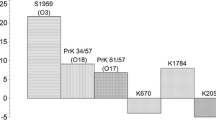Abstract
Planktonic and biofilm cells of a clinical urinary isolate ofP. aeruginosa were comparedin vitro for their ability to adhere to uroepithelial cells, interaction with macrophages, and for production of virulence factors like extracellular proteinase, elastase, hemolysin, phospholipase C and pyochelin. Biofilm cells showed increased adherence to UECs, which was coupled with reduced uptake and intracellular killing by macrophages. Overall there was a decrease in production of extracellular products by biofilm cells. Comparing the two cell forms for their ability to establish infection in an ascending model of acute pyelonephritis, significant enhancement of renal bacterial load, as well as more pronounced renal pathology developed with biofilm cells.
Similar content being viewed by others
Abbreviations
- FCS:
-
fetal calf serum
- PLC:
-
phospholipase C
- PBS:
-
phosphate buffered saline
- UEC:
-
uroepithelial cell
- p.i.:
-
post infection
- UTI:
-
urinary tract infection
References
Ababio G.O., Rogers J., Anwar H.: Effectiveness of ciprofloxacin microspheres in eradicating bacterial biofilm.J.Control.Rel. 57, 151–159 (1999)
Allen P.M., Fisher D., Saunder J.R., Hart C.A.: The role of capsular polysaccharide K21b ofKlebsiella and of structurally related colonic acid polysaccharide ofE. coli in resistance to phagocytosis and serum killing.J.Med.Microbiol. 24, 363–370 (1987).
Arnow L.E.: Calorimetric determination of the components of 3,4-dihydroxyphenylalanine-tyrosine mixture.J.Biol.Chem. 118, 531–537 (1937).
Carol P.: Forging link between biofilms and diseases.Science 283, 1837–1838 (1999).
CDC (Centers for Disease Control): Noscomial infection surveillance, 1980–1982, p. 155 inCDC Surveillance Summaries, Vol.32, no. 455. Centers for Disease Control, Atlanta 1983.
Dworniczek E., Kuzko K., Mroz E., Wojciech L., Adamski R., Sobieszczanska B., Seniuk A.: Virulence factors andin vitro adherence ofEnterococcus strains to urinary catheters.Folia Microbiol. 48, 671–678 (2003).
Garg U.C., Ganguly N.K., Sharma S., Chakravarti R.N., Bhatnagar R.K.: Quantitative histopathological methods for the evaluation of experimental ascending pyelonephritis.Med.Sci.Res. 15, 367–368 (1987).
Haberman E., Hardet K.L.: A sensitive and specific plate test for the quantitation of phospholipases.Anal.Biochem. 50, 163–164 (1972).
Hagberg L., Edenberg I., Freter R., Lam J., Olling S., Svanberg E.C.: Ascending unobstructed urinary tract infection in mice caused by pyelonephritogenicEscherichia coli of human origin.Infect.Immun. 40, 273–283 (1983).
Hawthorn L.A., Bruce A.W., Reid G.: Ability of uropathogens to bind to Tamm-Horsefall proteins coated renal tubular cells.Urol.Res. 19, 301–304 (1991).
Hoiby N., Johansen H.K., Moser C., Song Z., Ciofu O., Kharazmi A.:Pseudomonas aeruginosa and thein vitro andin vivo biofilm mode of growth.Microb.Infect. 3, 23–35 (2001).
Howe T.R., Iglewski B.H.: Isolation and characterization of alkaline protease deficient mutants ofPseudomonas aeruginosa in vitro and a mouse eye model.Infect.Immun. 43, 1058–1063 (1984).
Kadry A.A.: Lack of efflux mechanism in a clinical isolate ofPseudomonas aeruginosa highly resistant to β-lactams and imipenem.Folia Microbiol. 48, 529–535 (2003).
Kakkar K., Sharma S., Asnani P.J., Banerjee C.K., Sharma B.K.: Experimental baematogenous pyelonephritis in mice with uropathogenic enteropathogenic and enterotoxigenicEscherichia coli.Antonie van Leeuwenhoek 52, 153–161 (1986).
Kurosaka Y., Ishida Y., Yamamura E., Takase H., Otani T., Kumon H.: A non-surgical rat model of foreign body-associated urinary tract infectionPseudomonas aeruginosa.Microbiol.Immunol. 45, 9–15 (2001).
Leigh D.A., Emmanuel F.X.S.: The treatment ofPseudomonas aeruginosa urinary tract infections with norfloxacin.J.Antimicrob.Chemother. 13, 85–88 (1984).
Lerrer P., Gareer N.G.: Interactions ofPseudomonas aeruginosa PA-IIL lectin with quail egg white glycoproteins.Can.J.Microbiol. 47, 1095–1100 (2001).
Majtán V., Hoštacká A., Majtanová L'., Trupl J.: Toxinogenicity and markers of pathogenicity ofPseudomonas aeruginosa strains isolated from patients with tumor diseases.Folia Microbiol. 47, 445–449 (2002).
Marcus H., Baker N.R.: Quantitation of adherence of mucoid and non-mucoidPseudomonas aeruginosa to hamster tracheal epithelium.Infect.Immun. 47, 1–7 (1985).
Ohman D.E., Cryz S.J., Iglewski B.H.: Isolation and characterization of aPseudomonas aeruginosa PAO mutant that produces altered elastase.J.Bacteriol. 142, 836–842 (1980).
Parkinen J., Virkola R., Korhonen T.K.: Identification of factors in human urine that inhibit the binding ofEscherichia coli adhesins.Infect.Immun. 56, 2623–2630 (1988).
Shigeta M., Komatsuzawa H., Sugai M., Suginako H., Usci T.: Effect of the growth rate ofPseudomonas aeruginosa biofilms on the susceptibility to antimicrobial agents.Chemotherapy 43, 137–141 (1997).
Simpson J.A., Smith S.A., Dean R.E.: Alginate inhibition of the uptake ofPseudomonas aeruginosa by macrophages.J.Gen.Microbiol. 134, 29–36 (1988).
Taylor P.W.: Bactericidal and bacteriolytic activity of serum against Gram-negative bacteria.Microbiol.Rev. 47, 46–83 (1983).
Woods D.E., Sokol P.A., Bryan L.E., Storey D.G., Mattingly S.J., Vogel H.J., Ceri H.:In vivo regulation of virulence inPseudomonas aeruginosa associated with genetic rearrangement.J.Infect.Dis. 163, 143–149 (1991).
Yadav V., Harjai K., Joshi K., Sharma S.: Pyelonephritic potential ofPseudomonas aeruginosa in ascending mouse model.Indian J.Med.Res. 112, 93–99 (2000).
Author information
Authors and Affiliations
Rights and permissions
About this article
Cite this article
Yadav, V., Harjai, K., Kaur, R. et al. Urovirulence ofPseudomonas aeruginosa: Planktonic cellsvs. biofilm cells. Folia Microbiol 49, 465–470 (2004). https://doi.org/10.1007/BF02931610
Received:
Revised:
Published:
Issue Date:
DOI: https://doi.org/10.1007/BF02931610



